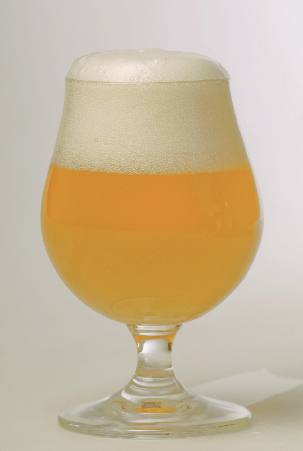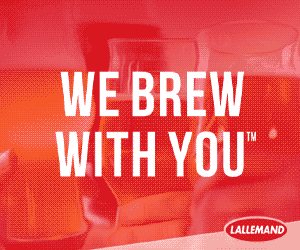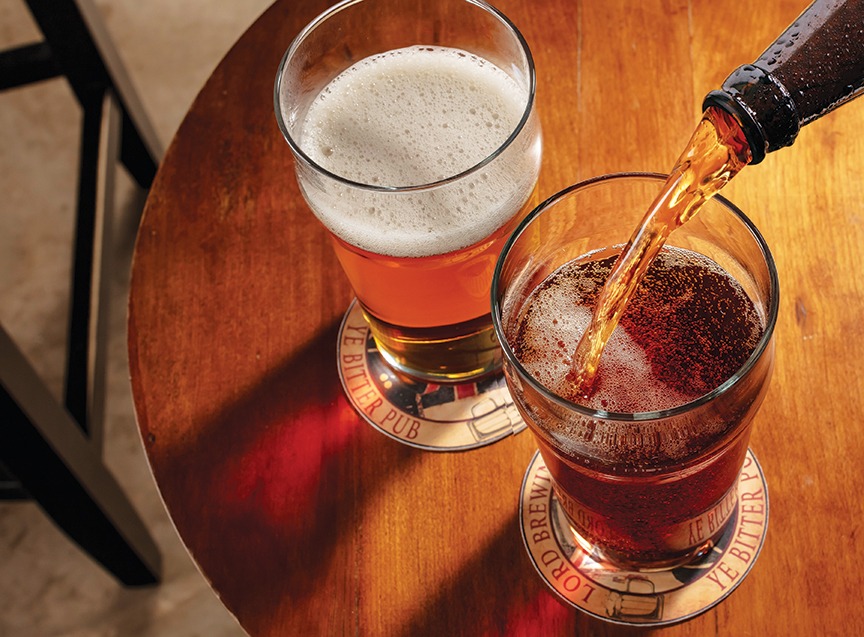Belgian Blond: Style Profile

That should not dissuade you from drinking or brewing Belgian blond. In fact, it is a great style, combining richness of flavors, aromas and alcohol, but with restraint, which is lacking in many other Belgian styles. Belgian blond ranges from 6.0 to 7.5% ABV with subtle, restrained spicy, fruity and alcohol flavors supported by a grainy, slightly sweet Pilsner malt character. While there might be a little upfront sweetness, good examples always finish dry and balanced. High carbonation and a medium body can contribute to a slightly creamy overall mouthfeel. While yeast character plays a highly significant role in most Belgian-style beers, in blond the yeast character should be a bit subtler. It is still complex and interesting, but Pilsner malt character is every bit as important. The gentle mix of fruity esters (lemon, orange, grapefruit, pear), sometimes light phenolic spiciness (pepper, clove) and smooth, slightly warming alcohols builds a complex but easy-drinking beer. These characteristic flavors and aromas come from malt and fermentation, not from the addition of fruits and spices.
The base malt for this style is continental Pilsner malt. Pilsner malt lends a slightly sweet, grainy malt character to the beer. If you can source it, Belgian Pilsner malt is ideal. If you cannot, do not worry, even Belgian brewers use other continental Pilsner malts. If you are an extract brewer, try to use an extract made from Pilsner malt. While it may seem like it is not worth the trouble, a beer like this does not have a lot of specialty malts to hide behind, so it is important to use a good quality Pilsner malt extract. Pilsner malt and some table sugar is really all you need, although some brewers will add other grains to help differentiate or enhance their beer. Oats, wheat, CaraPils®, aromatic, Vienna, Munich and other malts show up in various recipes.
Avoid caramel malts, especially those of higher color. Caramel flavor is not an appropriate character in blond. If you are going to experiment, focus on the grainy/bready malt flavors instead (such as biscuit, aromatic, Vienna, or Munich). You can experiment with other character grains, but remember this beer is more about the clean Pilsner malt character and fermentation flavors so do not overwhelm them with specialty malts. A little goes a long way — and even then it can be too much.
Belgian blond has a medium body and a dry finish. All-grain brewers should target a mash temperature around 150 °F (66 °C), which strikes a nice balance between fermentable and non-fermentable sugars. Simple sugar (table sugar) is a common ingredient in this style. Around 10% is a good starting point. Fermenting simple sugar does produce a different character than more complex sugars, and that is part of the style. For extract brewers, most extracts are not quite fermentable enough on their own, but by adjusting the amount of simple sugar used to create your starting gravity, you can get enough attenuation to make a fine example.
Hop character is restrained, with a low spicy, earthy or floral hop aroma and flavor. I prefer to stick with noble hops such as Saaz, Hallertau or Tettnang. Traditionally, breweries also use Styrian Goldings or Kent Goldings and I think in a pinch other varieties such as Mount Hood or Liberty are fine as well. You certainly do not need any late hop additions, but if you do, a single, small addition near the end of the boil is about all you can add and still consider the beer a “traditional” example. Plenty of commercial and homebrewers are experimenting with increased aroma and flavor additions with this style, but do not count on any of those types of experiments to do well in a homebrew competition if you plan on entering them as classic examples.
A good blond finishes dry, with not more than a medium bitterness. That dryness and bittering comes from alcohols, phenols, carbonation and hops. You can use any of the previously mentioned hops for bittering, striving to just balance the residual malt sweetness. The trick here is to keep in mind the contribution of alcohols and higher than average carbonation to the overall impression of bitterness. The bitterness-to-starting gravity ratio (IBU divided by OG) ranges between 0.25 and 0.5, although for most recipes a reasonable starting point is around 0.3 to 0.4.
There are many great yeast strains for brewing this style, but two of my favorites are White Labs WLP500 (Trappist Ale) and Wyeast 1214 (Belgian Ale). Other excellent choices are White Labs WLP530 (Abbey Ale), WLP540 (Abbey IV Ale Yeast), WLP550 (Belgian Ale Yeast) and Wyeast 1762 (Abbey II) or Wyeast 3787 (Trappist High Gravity). You cannot go wrong with any of these yeast strains. When selecting a yeast, keep in mind that the yeast always provides a great deal of the character of the finished beer. Any spicy, peppery notes you can taste in the finished beer are from yeast-produced phenols and the fruity notes are from yeast-produced esters. Whatever yeast you use, remember that your fermentation conditions affect what flavors and aromas the yeast produce. Pitching rate, oxygen level, nutrients, and temperature are like dials on your control panel of fermentation flavor. Getting the right settings is your job as a brewer.
With most of these yeasts I recommend pitching at a rate of 0.75 million cells per milliliter per degree Plato (see the pitching rate calculator at www.mrmalty.com for help in calculating this for your beer). Pitch the yeast at a cool temperature and allow about 24 hours for yeast growth and then ramp up the temperature for the rest of fermentation to ensure good attenuation. For example, pitch the yeast at 64 °F (18 °C) and raise the temperature to 70 °F (21 °C) over the course of a couple days. You may find that a higher or lower temperature gives you the ideal result, so do not
be afraid to tweak the temperatures and pitching rate until you get it right. Do not let “how the big brewery does it” determine your process unless you are using the same equipment and methods.
One concern when brewing most Belgian-style beers is getting enough attenuation. Many brewers go with lower and lower mash temperatures in an attempt to achieve this, but that is not necessarily the problem. You do not need to get rid of all the long chain dextrins to make a dry beer. Those long chain dextrins are not very sweet and they can be present in a nice, dry beer. The most important thing is to make sure you ferment out all the simpler sugars completely. If you leave a lot of maltose behind unfermented, then the beer is going to taste sweet, even though it might attenuate well. Starting with a healthy pitch of yeast, aerating or oxygenating, and controlling temperatures are the key to getting a dry finish.
If you are having trouble getting a dry beer, one trick that seems to help is waiting until the fermentation is nearly done before adding the simple sugars. Wait until fermentation has started to slow down and then add the sugar. Adding the sugar after the yeast has consumed the maltose is like telling your kids to finish their dinner before they can have dessert. If you do not do that, sometimes the yeast will fill up on dessert first and have little desire to eat their dinner afterwards.
Oxygen is important to yeast health and is necessary for fermentation to reach terminal gravity in a reasonable amount of time. However, too much or too little oxygen can have unintended consequences, so adding the right amount of oxygen is important. That is difficult for many homebrewers, but at least you should try to control the amount of oxygen you are adding by timing and flow rate. The amount of oxygen needed is a balancing act along with the amount of yeast pitched. Initially adding oxygen reduces the amount of esters yeast produce, but high levels of oxygen also increase the amount of fusel alcohols, which are also a substrate for ester production. Keep in mind the need for a restrained Belgian fermentation character in this style. Playing around with the amount of oxygen and the pitching rate can make a huge difference. If you are using air, there is no chance of over-aerating your wort, but there is a chance of under-aerating. If you are using oxygen with a sintered stone, a good starting point for 5 US gallons (19 L) is a flow of 1 L per minute for 1 minute. You might go up or down from there, as experience shows you what is right for your beer.
Recipe
Belgian Blond
(5 gallons/19 L, all-grain)
OG = 1.065 (15.8 °P)
FG = 1.012 (3.0 °P)
IBU = 25 SRM = 5 ABV: = 7.0%
Ingredients
9.9 lb. (4.5 kg) Best Malz Pilsen (or similar continental Pilsner) malt (2 °L)
1.2 lbs. (560 g) cane or beet Sugar (0 °L)
7 oz. (200 g) Franco-Belges aromatic malt (20 °L)
7 oz. (200 g) Great Western wheat malt (2 °L)
5.6 AAU Hallertau pellet hops (1.4 oz./39 g at 4% alpha acids) (60 min.)
White Labs WLP500 (Trappist Ale) or Wyeast 1214 (Belgian Ale) yeast
Step by Step
Belgian Pilsner malt is the natural choice for the base malt. Feel free to substitute any high quality malt of a similar flavor and color from a different supplier. The sugar I use is the cheapest table sugar I can find at my warehouse store. Mill the grains and dough-in targeting a mash of around 1.5 quarts of water to 1 pound of grain (a liquor-to-grist ratio of about 3:1 by weight) and a temperature of 150 °F (66 °C). Hold the mash at 150 °F (66 °C) until enzymatic conversion is complete. Infuse the mash with near-boiling water while stirring or with a recirculating mash system raise the temperature to mash out at 168 °F (76 °C). Sparge slowly with 170 °F (77 °C) water, collecting wort until the pre-boil kettle volume is around 6.5 gallons (24.4 L) and the gravity is 1.050 (12.4 °P).
The total wort boil time is 90 minutes, which helps reduce the S-Methyl methionine (SMM) present in the lightly kilned Pilsner malt and results in less Dimethyl Sulfide (DMS) in the finished beer. Add the bittering hops with 60 minutes remaining in the boil. Add the sugar with 15 minutes left in the boil. Chill the wort rapidly to 64 °F (18 °C), let the break material settle, rack to the fermenter, pitch the yeast and aerate thoroughly.
You will need 2 packages of liquid yeast or you can make a 2.5L starter from 1 package. Pitch yeast at 64 °F (18 °C), aerate or oxygenate, and let the temperature rise slowly to 68 °F (20 °C) over the course of several days. Ferment until the yeast drops clear. With healthy yeast, fermentation should be complete in a week, but do not rush it. It is important for the beer to attenuate fully. Rack to a keg and force carbonate or rack to a bottling bucket, add priming sugar, and bottle. When finished, carbonate the beer to approximately 3 volumes.
Belgian Blond
(5 gallons/19 L, extract with grains)
OG = 1.065 (15.8 °P)
FG = 1.012 (3.0 °P)
IBU = 25 SRM = 5 ABV = 7.0%
Ingredients
6.6 lb. (3 kg) Pilsner liquid malt extract (LME) (2 °L)
1 lb. (0.45 kg) light dried malt extract
1.1 lb. (500 g) cane or beet sugar (0 °L)
7 oz. (200 g) Franco-Belges aromatic malt (20 °L)
5.6 AAU Hallertau pellet hops (1.4 oz./39 g at 4% alpha acids) (60 min.)
White Labs WLP500 (Trappist Ale) or Wyeast 1214 (Belgian Ale) yeast
Step by Step
Try to find a Pilsner-type liquid malt extract made from 100% Pilsner malt, but feel free to substitute any high quality malt extract of a similar flavor and color. If you cannot get fresh liquid malt extract, it is better to use an appropriate amount of dry malt extract (DME) instead, since it does not oxidize nearly as fast and tends to be fresher. The sugar I use is the cheapest table sugar I can find at my warehouse store.
Because it can be tricky to get aromatic malt to convert by itself, you can consider the aromatic malt optional. You can omit it completely or replace it with a few ounces of Munich malt extract. If you do use the aromatic malt, it is best to try and get it to convert in a very simple mini mash. Mill or coarsely crack the aromatic malt and add it to 16 oz (0.5 L) of 158 °F (70 °C) water. Mix the grains until completely moist, and then do your best to keep the temperature between 150 and 160 °F (66 and 71 °C) for 30 minutes to one hour. You can do this by setting the container in a larger pot of hot water or wrapping it in a heating pad set on high. The warmer the temperature, the less time it will take to convert the starches, but don’t let it go higher than 160 °F (71 °C) to avoid accidentally denaturing the enzymes in the malt. When done the liquid will taste slightly sweet. If it doesn’t taste sweet, it didn’t convert. Strain out the grains and rinse with warm water. Add the liquid from the mini mash along with enough water and malt extract to make a pre-boil volume of 5.9 gallons (22.3 L) and a gravity of 1.055 (13.6 °P). Stir thoroughly to help dissolve the extract and bring to a boil. Once the wort is boiling, add the bittering hops. The total wort boil time is 1 hour after adding the bittering hops. Add the sugar with 15 minutes left in the boil. Chill the wort rapidly to 64 °F (18 °C), let the break material settle, rack to the fermenter, pitch the yeast and aerate thoroughly.
You will need 2 packages of liquid yeast or you can make a 2.5L starter from 1 package. Pitch yeast at 64 °F (18 °C), aerate or oxygenate, and let the temperature rise slowly to 68 °F (20 °C) over the course of several days. Ferment until the yeast drops clear. With healthy yeast, fermentation should be complete in a week, but do not rush it. It is important for the beer to attenuate fully. Rack to a keg and force carbonate or rack to a bottling bucket, add priming sugar, and bottle. When finished, carbonate the beer to approximately 3 volumes.



